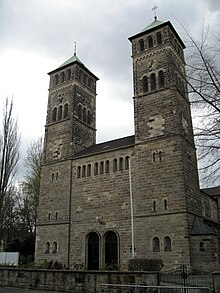Trinity Church (Dortmund)
The Catholic Dreifaltigkeitskirche in Dortmund's northern part of the city is located near Borsigplatz at Flurstrasse 10. The community is one of the Catholic parishes in the outskirts of Dortmund city center that were founded as part of industrialization . The Catholic workers who immigrated to work in the coal and steel industry were to find a religious home in these communities in Protestant Dortmund.
history
According to information from the pastoral association Dortmund-Nordstadt-Ost, the population in the Hoeschviertel in the vicinity of the Westfalenhütte had grown to 13,207 people around 1900, including many Catholic immigrants from Hesse, Silesia, Posen, West and East Prussia, the Rhineland and other parts of Westphalia. The church was created as a subsidiary parish of St. Joseph and only became a separate parish after the church was built . In 1900 the construction in the style of a Romanesque basilica with a cross-shaped floor plan and a double tower on the street was completed. The architect was Johannes Franziskus Klomp . In 1903 the community built the Vincenz orphanage and in 1908 a club house.
During the National Socialist dictatorship, the then pastor Theodor Leppert was arrested in 1935 and imprisoned in the Dortmund Steinwache and later in Berlin-Moabit .
During the Second World War , the church was destroyed in bombing raids from 1943 to 1945 and was not rebuilt until 1954. The plans for this came from the architect Hermann Kessemeier , who was also responsible for the reconstruction of other churches in Dortmund ( Marien and Petrikirche ). In addition to numerous external changes such as the abandonment of the transept, erection of flat tent roofs instead of pointed spiers , redesign of the facade and the entrance door, the interior of the church was also significantly changed. The interior of the church with the flat wooden beam ceiling and the two rows of columns to the left and right of the main nave looks simple and functional. In the area of the apse , the beamed ceiling is replaced by a wooden rosette with a dove (symbolizing the Holy Spirit ) in its center.
The congregation belongs with St. Antonius, St. Joseph and the Portuguese Mission to the pastoral network of Dortmund Nordstadt-Ost. Due to the sharp decline in the Catholic population in the Hoeschviertel in the vicinity of the Westfalenhütte in Dortmund's northern part of the city from 7,500 after the Second World War to 3,711 parishioners in 1975 and, according to the congregation, today 2,000 believers from over 30 nations, the amalgamation of the parishes became necessary.
Ballspielverein Borussia 09 eV Dortmund , which separated from the parish in 1909 in the conflict over what , in the opinion of the responsible chaplain Hubert Dewald, was “raw” football, emerged from the congregation's Catholic youth modality “Dreifaltigkeit” .
Leading clergy
| Period | function | Surname |
|---|---|---|
| 1900-1904 | Rector | Klemens Cloidt |
| 1904-1919 | Pastor | Klemens Cloidt |
| 1919-1953 | Pastor | Theodor Lepper |
| 1953-1979 | Pastor | Aloys Niedermeier |
| 1979-1988 | Pastor | Ludger sergeant |
| 1988 | Parish administrator | Egbert Plich |
| 1988/89 | Parish administrator | Joachim Nowak |
| 1989-1991 | Pastor | Joachim Nowak |
| 1991-2004 | Pastor | Gottfried Marx |
| 2004-2007 | Parish administrator / head of the pastoral network | Hermann Daniel |
| 2007–2012 | Pastor / head of the pastoral network | Jörg Haselhorst |
| since July 2012 | Pastor / head of the pastoral network | Ansgar shock |
literature
- Dietrich Schulze-Marmeling, Fame, Dream and Money: The History of Borussia Dortmund. The workshop, Göttingen 2005, ISBN 3-89533-480-4 .
- Paul Montag, Elisabeth Tillmann, Brigitte Spieker, Dieter Höltershinken (eds.), The Catholic Church in Dortmund. Your history and parishes, Paderborn 2006, ISBN 3897103656 .
- Ingo Grabowsky, Peter Kroos, Richard Schmalöer (eds.), Churches of the post-war period. Boom years of sacred architecture in Dortmund, Ardey-Verlag, Münster 2010, ISBN 9783870233389 .
Web links
- Page of the pastoral network
- Link to a draft of the structure from 1897/1898
- Description of this sight on the route of industrial culture
Sources and Notes
- ↑ Dietrich Schulze-Marmeling, Fame, Dream and Money: The Story of Borussia Dortmund, p. 24
- ↑ Website of the pastoral network, see the subpage "History"
- ↑ Churches of the post-war period. Boom years of sacred architecture in Dortmund, pp. 95–97
Coordinates: 51 ° 31 '34.2 " N , 7 ° 29' 5.5" E




